Effect of Penetrative Combustion on Regression Rate of 3D Printed Hybrid Rocket Fuel
Abstract
:1. Introduction
2. Fuel Grain Fabrication
3. Characteristics of ABS Fuel Grains
3.1. FTIR Analysis
3.2. Thermal Analyses
3.3. Microstructure Characterization
3.4. Hybrid Combustion
3.5. Regression Rate Evaluation
4. Results and Discussion
5. Conclusions
Author Contributions
Funding
Data Availability Statement
Conflicts of Interest
References
- Chiaverini, M. Review of Solid-Fuel Regression Rate Behavior in Classical and Nonclassical Hybrid Rocket Motors. In Fundamentals of Hybrid Rocket Combustion and Propulsion; American Institute of Aeronautics and Astronautics: Reston, VA, USA, 2007; pp. 37–126. [Google Scholar]
- Mazzetti, A.; Merotto, L.; Pinarello, G. Paraffin-based hybrid rocket engines applications: A review and a market perspective. Acta Astronaut. 2016, 126, 286–297. [Google Scholar] [CrossRef]
- Cantwell, B.; Karabeyoglu, A.; Altman, D. Recent advances in hybrid propulsion. Int. J. Energ. Mater. Chem. Propuls. 2010, 9, 305–326. [Google Scholar] [CrossRef]
- Calabro, M. Overview on hybrid propulsion. Prog. Propuls. Phys. 2012, 2, 353–374. [Google Scholar]
- John, J.; Nandagopalan, P.; Baek, S.W.; Miglani, A. Rheology of solid-like ethanol fuel for hybrid rockets: Effect of type and concentration of gellants. Fuel 2017, 209, 96–108. [Google Scholar] [CrossRef]
- Altman, D. Overview and History of Hybrid Rocket Propulsion. In Fundamentals of Hybrid Rocket Combustion and Propulsion; American Institute of Aeronautics and Astronautics: Reston, VA, USA, 2007; pp. 1–36. [Google Scholar]
- Cardoso, K.P.; Ferrão, L.F.A.; Kawachi, E.Y.; Araújo, T.B.; Nunes, R.F.; Nagamachi, M.Y. Preparation of Paraffin-Based Solid Combustible for Hybrid Propulsion Rocket Motor. J. Propuls. Power 2017, 33, 448–455. [Google Scholar] [CrossRef]
- DeSain, J.D.; Brady, B.B.; Metzler, K.M.; Curtiss, T.J.; Albright, T.V. Tensile tests of paraffin wax for hybrid rocket fuel grains. In Proceedings of the 45th AIAA/ASME/SAE/ASEE Joint Propulsion Conference & Exhibit, Denver, CO, USA, 2–5 August 2009; American Institute of Aeronautics and Astronautics: Reston, VA, USA, 2009; Volume 5115, pp. 1–27. [Google Scholar]
- Sakote, R.; Yadav, N.; Karmakar, S.; Joshi, P.C.; Chatterjee, A.K. Regression Rate Studies of Paraffin Wax-HTPB Hybrid Fuels Using Swirl Injectors. Propellants Explos. Pyrotech. 2014, 39, 859–865. [Google Scholar] [CrossRef]
- Sossi, A.; Duranti, E.; Manzoni, M.; Paravan, C.; DeLuca, L.T.; Vorozhtsov, A.B.; Lerner, M.I.; Rodkevich, N.G.; Gromov, A.A.; Savin, N. Combustion of HTPB-Based Solid Fuels Loaded with Coated Nanoaluminum. Combust. Sci. Technol. 2013, 185, 17–36. [Google Scholar] [CrossRef]
- Sun, X.; Tian, H.; Li, Y.; Yu, N.; Cai, G. Regression rate behaviors of HTPB-based propellant combinations for hybrid rocket motor. Acta Astronaut. 2016, 119, 137–146. [Google Scholar] [CrossRef]
- Pal, Y.; Kumar, V.R. Physical and Ballistic Characterization of Aluminum-Loaded Paraffin Hybrid Rocket Fuels. Energy Fuels 2017, 31, 10133–10143. [Google Scholar] [CrossRef]
- Tang, Y.; Chen, S.; Zhang, W.; Shen, R.; DeLuca, L.T.; Ye, Y. Mechanical Modifications of Paraffin-based Fuels and the Effects on Combustion Performance. Propellants Explos. Pyrotech. 2017, 42, 1268–1277. [Google Scholar] [CrossRef]
- Sun, X.; Tian, H.; Yu, N.; Cai, G. Regression rate and combustion performance investigation of aluminum metallized HTPB/98HP hybrid rocket motor with numerical simulation. Aerosp. Sci. Technol. 2015, 42, 287–296. [Google Scholar] [CrossRef]
- Yu, H.; Chen, S.; Yu, X.; Zhang, W.; Paravan, C.; DeLuca, L.T.; Shen, R. Nickel acetylacetonate as decomposition catalyst for HTPB-based fuels: Regression rate enhancement effects. Fuel 2021, 305, 121539. [Google Scholar] [CrossRef]
- Wang, X.; Jiang, M.; Zhou, Z.; Gou, J.; Hui, D. 3D printing of polymer matrix composites: A review and prospective. Compos. Part B Eng. 2017, 110, 442–458. [Google Scholar] [CrossRef]
- Lee, J.-Y.; An, J.; Chua, C.K. Fundamentals and applications of 3D printing for novel materials. Appl. Mater. Today 2017, 7, 120–133. [Google Scholar] [CrossRef]
- Bauer, C.; Metsker, Y.; Sethe, C.; Mutschler, M.; Bambauer, M.; Lungu, P.; Brandl, M. Application of Additive manufacturing in Solid and Hybrid Grain Design. In Proceedings of the 52nd AIAA/SAE/ASEE Joint Propulsion Conference, Salt Lake City, Salt Lake City, UT, USA, 25–27 July 2016; American Institute of Aeronautics and Astronautics: Reston, VA, USA, 2016; pp. 2016–4697. [Google Scholar]
- Chandru, R.A.; Balasubramanian, N.; Oommen, C.; Raghunandan, B.N. Additive Manufacturing of Solid Rocket Propellant Grains. J. Propuls. Power 2018, 34, 1090–1093. [Google Scholar] [CrossRef]
- Armold, D.; Boyer, J.E.; Kuo, K.; Fuller, J.K.; Desain, J.; Curtiss, T.J. Test of Hybrid Rocket Fuel Grains with Swirl Patterns Fabricated Using Rapid Prototyping Technology. In Proceedings of the 49th AIAA/ASME/SAE/ASEE Joint Propulsion Conference, San Jose, CA, USA, 14–17 July 2013; American Institute of Aeronautics and Astronautics: Reston, VA, USA, 2013; pp. 2013–4141. [Google Scholar]
- Whitmore, S.A.; Walker, S.D.; Merkley, D.P.; Sobbi, M. High Regression Rate Hybrid Rocket Fuel Grains with Helical Port Structures. In Proceedings of the 50th AIAA/ASME/SAE/ASEE Joint Propulsion Conference, Cleveland, OH, USA, 28–30 July 2014; American Institute of Aeronautics and Astronautics: Reston, VA, USA, 2015; pp. 1727–1738. [Google Scholar]
- Armold, D.; Boyer, E.; McKnight, B.; DeSain, J.; Fuller, J.K.; Kuo, K.; Brady, B.; Curtiss, T. Performance Characterization of Hybrid Rocket Fuel Grains with Complex Port Geometries Fabricated Using Rapid Prototyping Technology. Int. J. Energetic Mater. Chem. Propuls. 2014, 13, 287–307. [Google Scholar] [CrossRef]
- Creech, M.; Crandell, A.; Eisenhauer, N.; Marx, S.; Busari, T.; Link, A.; Gabl, J.; Pourpoint, T.L. 3D Printer for Paraffin Based Hybrid Rocket Fuel Grains. In Proceedings of the 53rd AIAA Aerospace Sciences Meeting, Kissimmee, FL, USA, 5–9 January 2015; American Institute of Aeronautics and Astronautics: Reston, VA, USA, 2015; p. 0924. [Google Scholar]
- McFarland, M.; Antunes, E. Small-Scale Static Fire Tests of 3D Printing Hybrid Rocket Fuel Grains Produced from Different Materials. Aerospace 2019, 6, 81. [Google Scholar] [CrossRef] [Green Version]
- Oztan, C.; Ginzburg, E.; Akin, M.; Zhou, Y.; Leblanc, R.M.; Coverstone, V. 3D printed ABS/paraffin hybrid rocket fuels with carbon dots for superior combustion performance. Combust. Flame 2021, 225, 428–434. [Google Scholar] [CrossRef]
- Bisin, R.; Paravan, C.; Alberti, S.; Galfetti, L. A new strategy for the reinforcement of paraffin-based fuels based on cellular structures: The armored grain—Mechanical characterization. Acta Astronaut. 2020, 176, 494–509. [Google Scholar] [CrossRef]
- Wang, Z.; Lin, X.; Li, F.; Yu, X. Combustion performance of a novel hybrid rocket fuel grain with a nested helical structure. Aerosp. Sci. Technol. 2020, 97, 105613. [Google Scholar] [CrossRef]
- Zhang, S.; Hu, F.; Zhang, W. Numerical investigation on the regression rate of hybrid rocket motor with star swirl fuel grain. Acta Astronaut. 2016, 127, 384–393. [Google Scholar] [CrossRef]
- Wu, Y.; Zhang, Z.; Wang, Q.; Wang, N. Combustion characteristics of skeleton polymer reinforced paraffin-wax fuel grain for applications in hybrid rocket motors. Combust. Flame 2022, 241, 112055. [Google Scholar] [CrossRef]
- Andersen, E.; Bertelsen, L.H.; Salomonsen, M.; Kristensen, M.; Kybelund, P.; Sørensen, M.B.; Hinge, M. Accelerating effect of pigments on poly(acrylonitrile butadiene styrene) degradation. Polym. Degrad. Stab. 2020, 178, 109183. [Google Scholar] [CrossRef]
- Liu, G.; Liao, Y.; Ma, X. Thermal behavior of vehicle plastic blends contained acrylonitrile-butadiene-styrene (ABS) in pyrolysis using TG-FTIR. Waste Manag. 2017, 61, 315–326. [Google Scholar] [CrossRef] [PubMed]
- Feng, J.; Sun, Y.; Song, P.; Lei, W.; Wu, Q.; Liu, L.; Yu, Y.; Wang, H. Fire-Resistant, Strong, and Green Polymer Nanocomposites Based on Poly(lactic acid) and Core–Shell Nanofibrous Flame Retardants. ACS Sustain. Chem. Eng. 2017, 5, 7894–7904. [Google Scholar] [CrossRef]
- Zhang, Y.; Hu, Y.; Wang, J.; Tian, W.; Liew, K.M.; Zhang, Y.; Wang, B. Engineering carbon nanotubes wrapped ammonium polyphosphate for enhancing mechanical and flame retardant properties of poly(butylene succinate). Compos. Part A Appl. Sci. Manuf. 2018, 115, 215–227. [Google Scholar] [CrossRef]
- Chen, R.; Lu, S.; Zhang, Y.; Lo, S. Pyrolysis study of waste cable hose with thermogravimetry/Fourier transform infrared/mass spectrometry analysis. Energy Convers. Manag. 2017, 153, 83–92. [Google Scholar] [CrossRef]
- Chen, F.Z.; Qian, J.L. Studies on the thermal degradation of polybutadiene. Fuel Process. Technol. 2000, 67, 53–60. [Google Scholar] [CrossRef]
- Bozi, J.; Czégény, Z.; Blazsó, M. Conversion of the volatile thermal decomposition products of polyamide-6,6 and ABS over Y zeolites. Thermochim. Acta 2008, 472, 84–94. [Google Scholar] [CrossRef]
- DeLuca, L.T.; Galfetti, L.; Maggi, F.; Colombo, G.; Merotto, L.; Boiocchi, M.; Paravan, C.; Reina, A.; Tadini, P.; Fanton, L. Characterization of HTPB-based solid fuel formulations: Performance, mechanical properties, and pollution. Acta Astronaut. 2013, 92, 150–162. [Google Scholar] [CrossRef]
- DeLuca, L.T.; Galfetti, L.; Colombo, G.; Maggi, F.; Bandera, A.; Boiocchi, M.; Gariani, G.; Merotto, L.; Paravan, C.; Reina, A. Time-resolved burning of solid fuels for hybrid rocket propulsion. Prog. Propuls. Phys. 2012, 2, 405–426. [Google Scholar]
- Paravan, Nano-Sized and Mechanically Activated Composites: Perspectives for Enhanced Mass Burning Rate in Aluminized Solid Fuels for Hybrid Rocket Propulsion. Aerospace 2019, 6, 127. [CrossRef]
- Chen, S.; Tang, Y.; Yu, H.; Guan, X.; DeLuca, L.T.; Zhang, W.; Shen, R.; Ye, Y. Combustion enhancement of hydroxyl-terminated polybutadiene by doping multiwall carbon nanotubes. Carbon 2019, 144, 472–480. [Google Scholar] [CrossRef]
- Chen, S.; Tang, Y.; Yu, H.; Bao, L.; Zhang, W.; DeLuca, L.T.; Shen, R.; Ye, Y. The rapid H2 release from AlH3 dehydrogenation forming porous layer in AlH3/hydroxyl-terminated polybutadiene (HTPB) fuels during combustion. J. Hazard. Mater. 2019, 371, 53–61. [Google Scholar] [CrossRef] [PubMed]
- Whitmore, S.A.; Walker, S.D. Engineering Model for Hybrid Fuel Regression Rate Amplification Using Helical Ports. J. Propuls. Power 2017, 33, 398–407. [Google Scholar] [CrossRef]
- Paravan, C.; Galfetti, L.; Bisin, R.; Piscaglia, F. Combustion processes in hybrid rockets. Int. J. Energetic Mater. Chem. Propuls. 2019, 18, 255–286. [Google Scholar] [CrossRef]
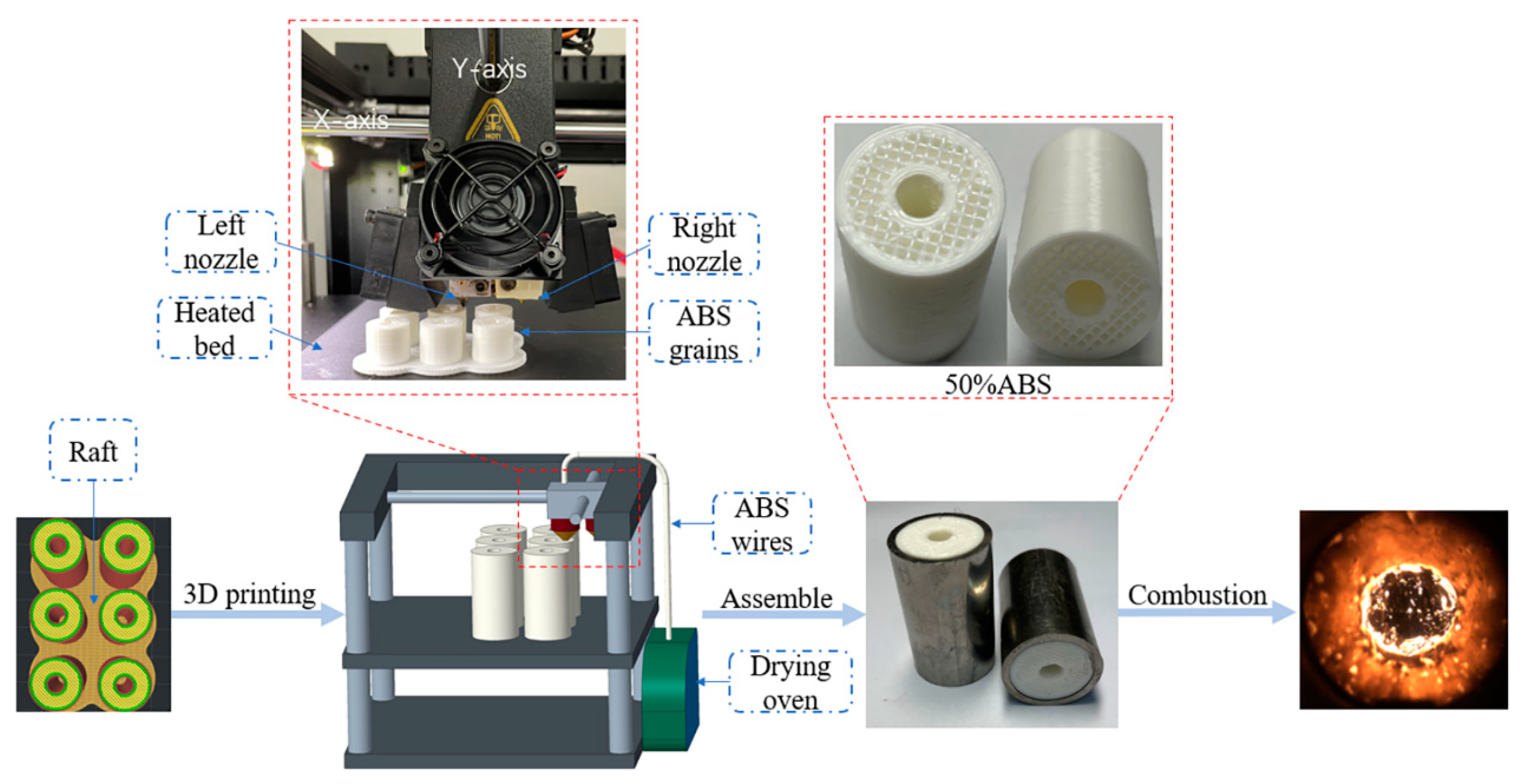
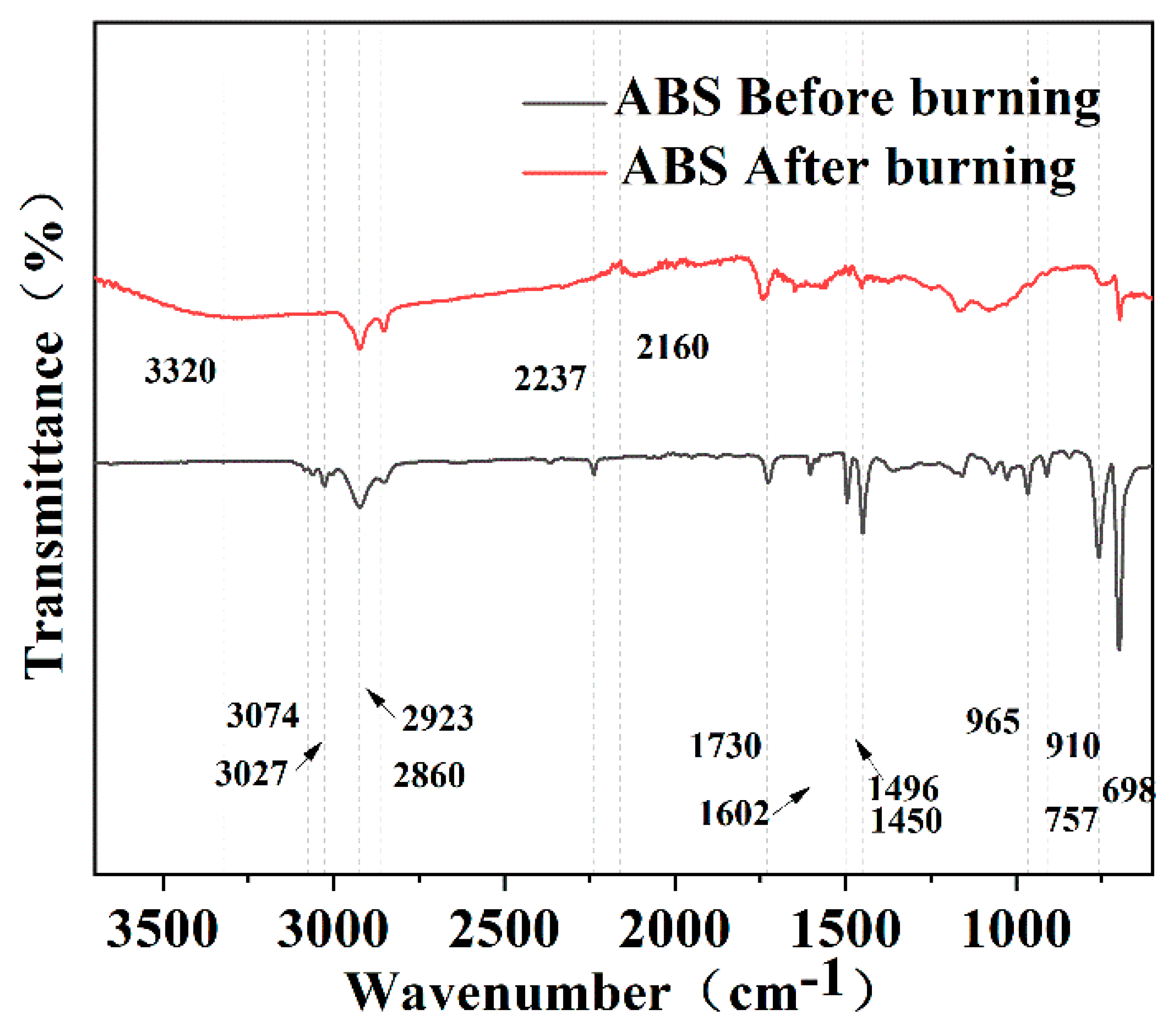
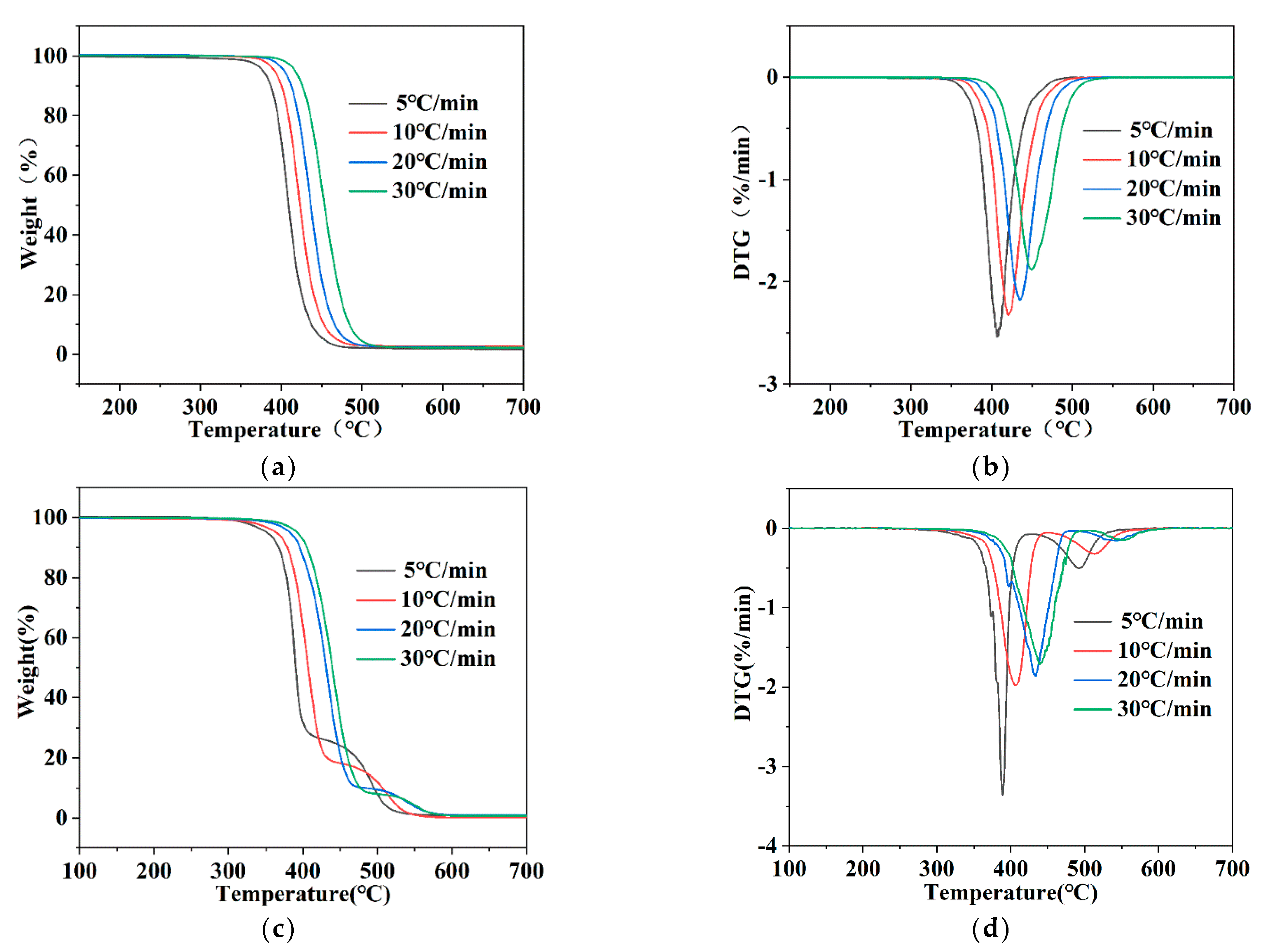
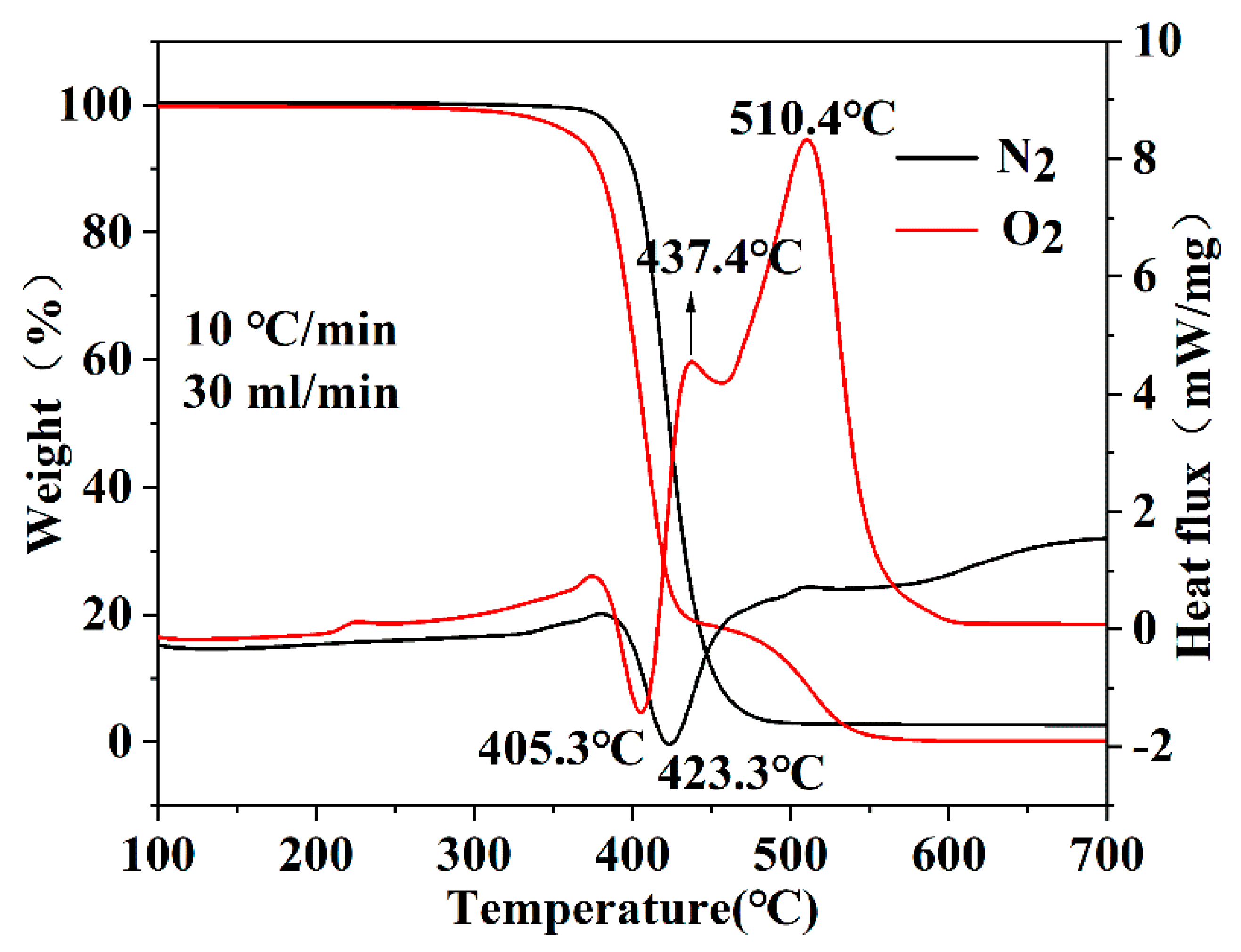
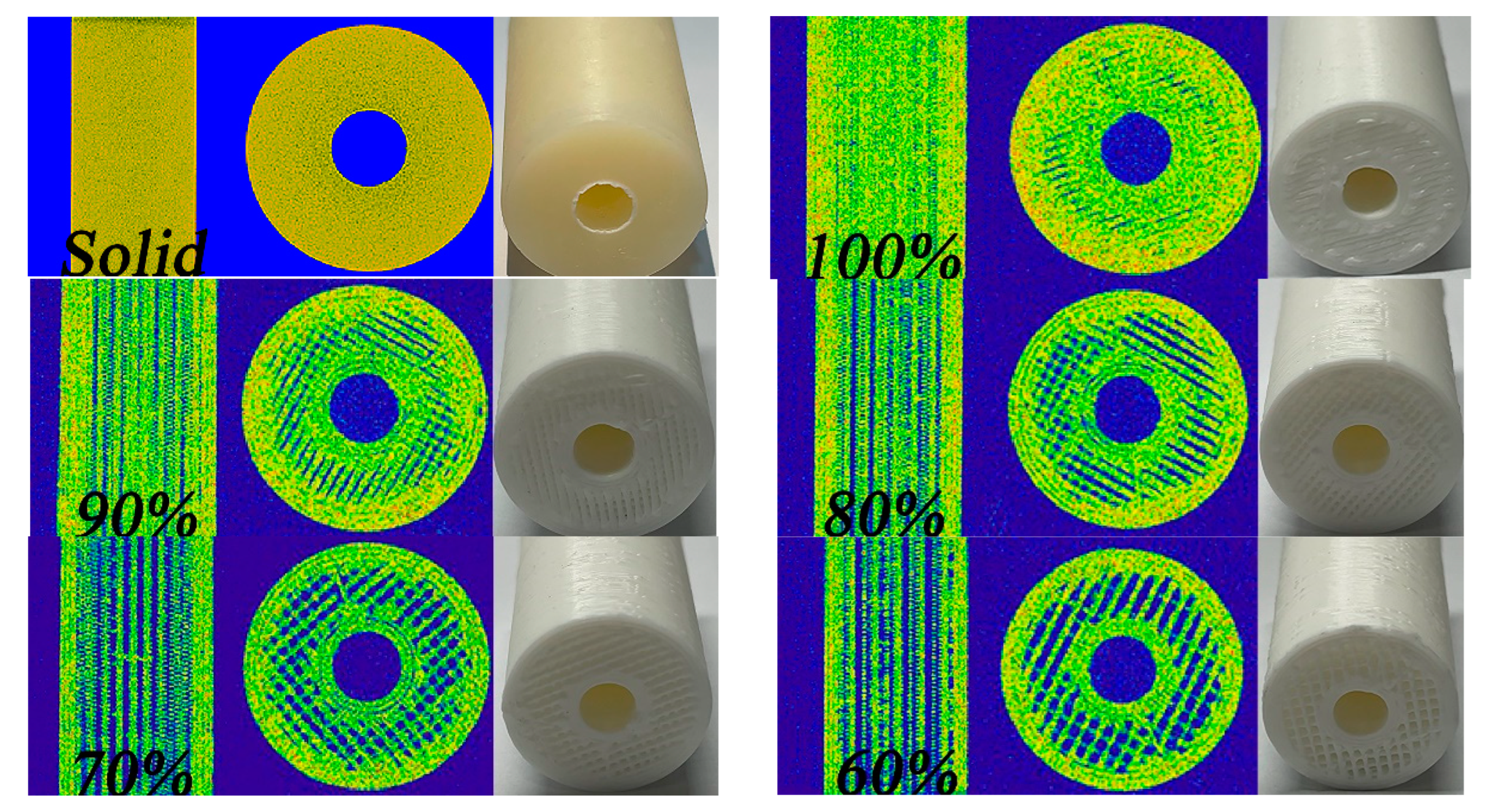
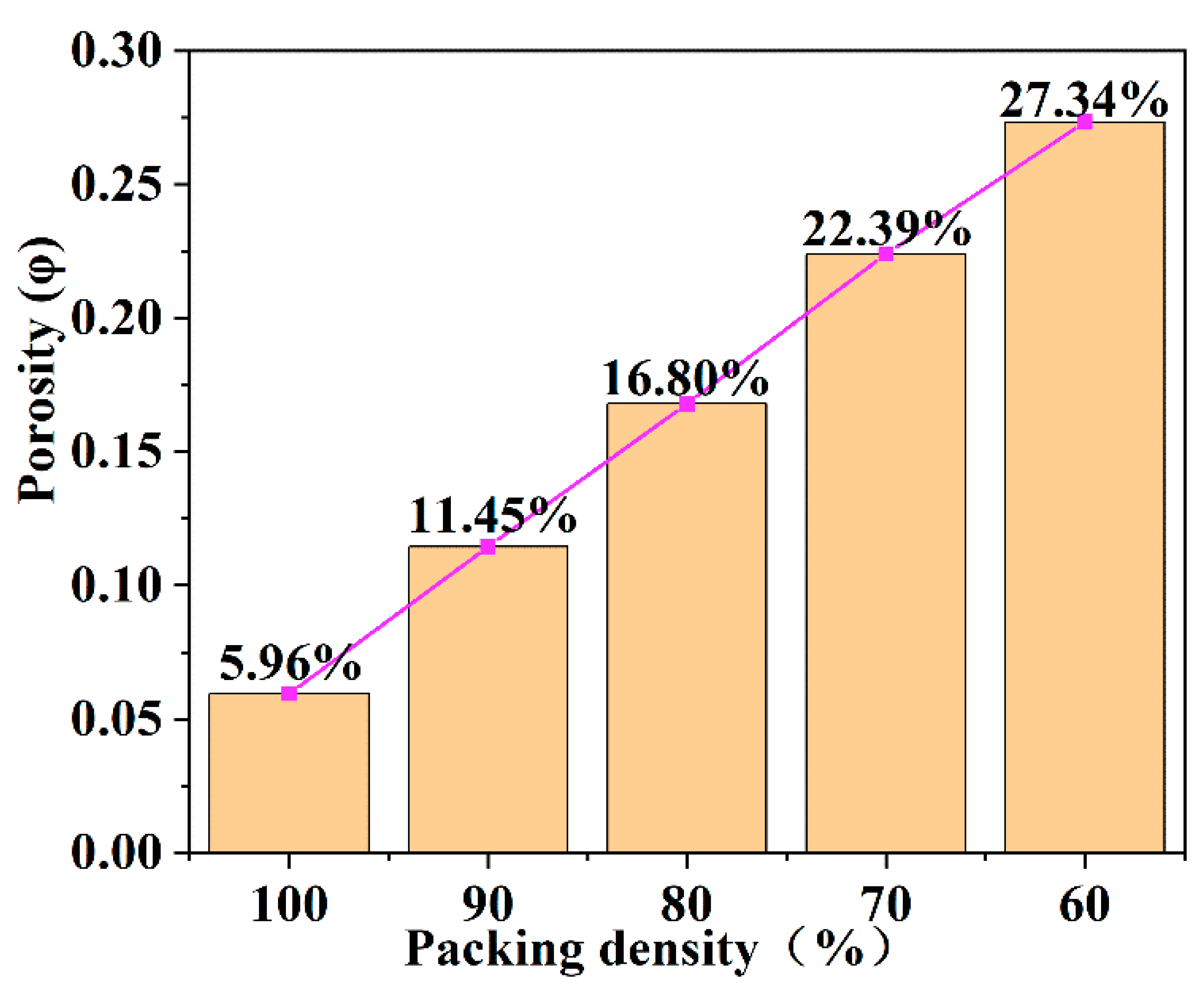

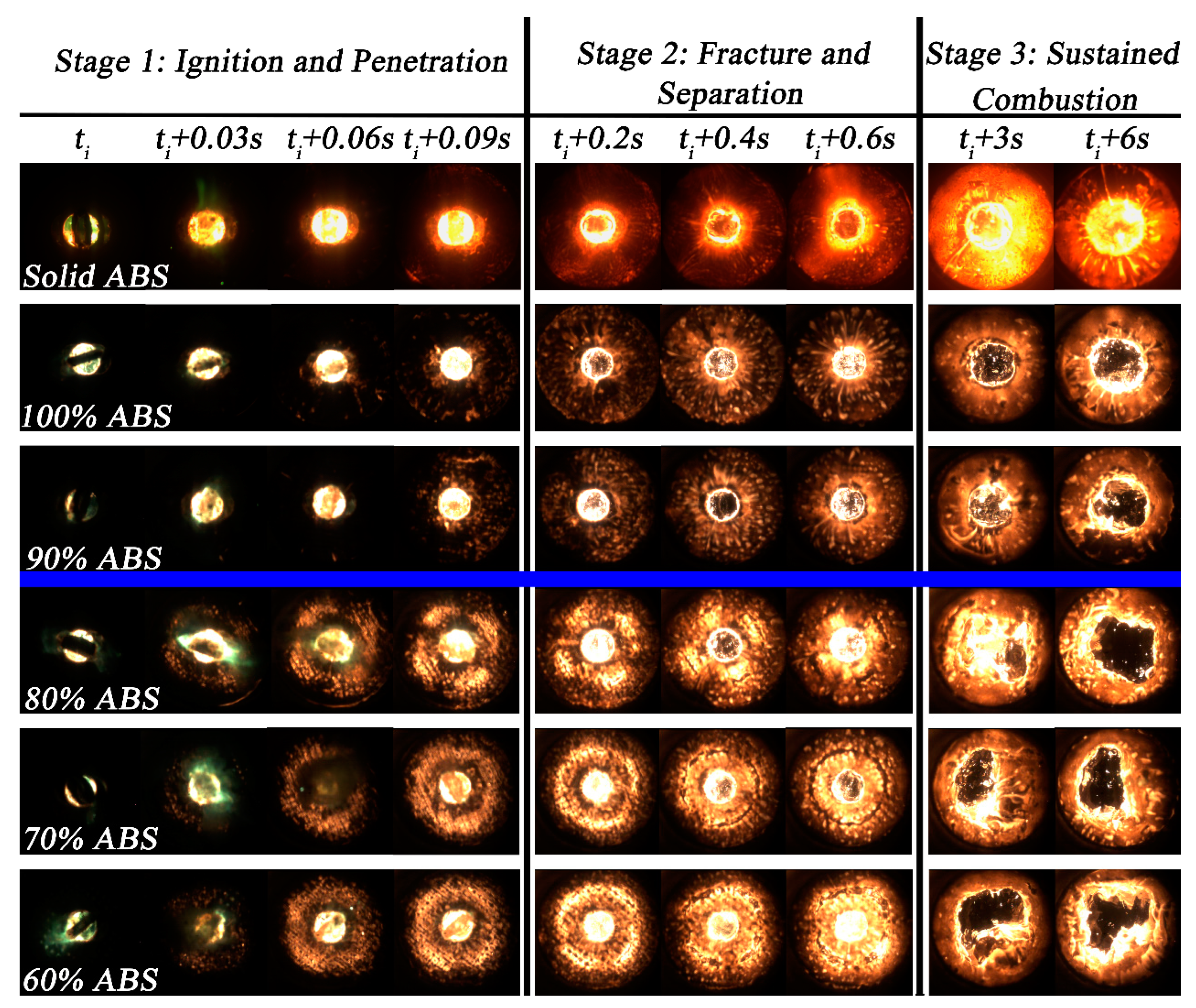
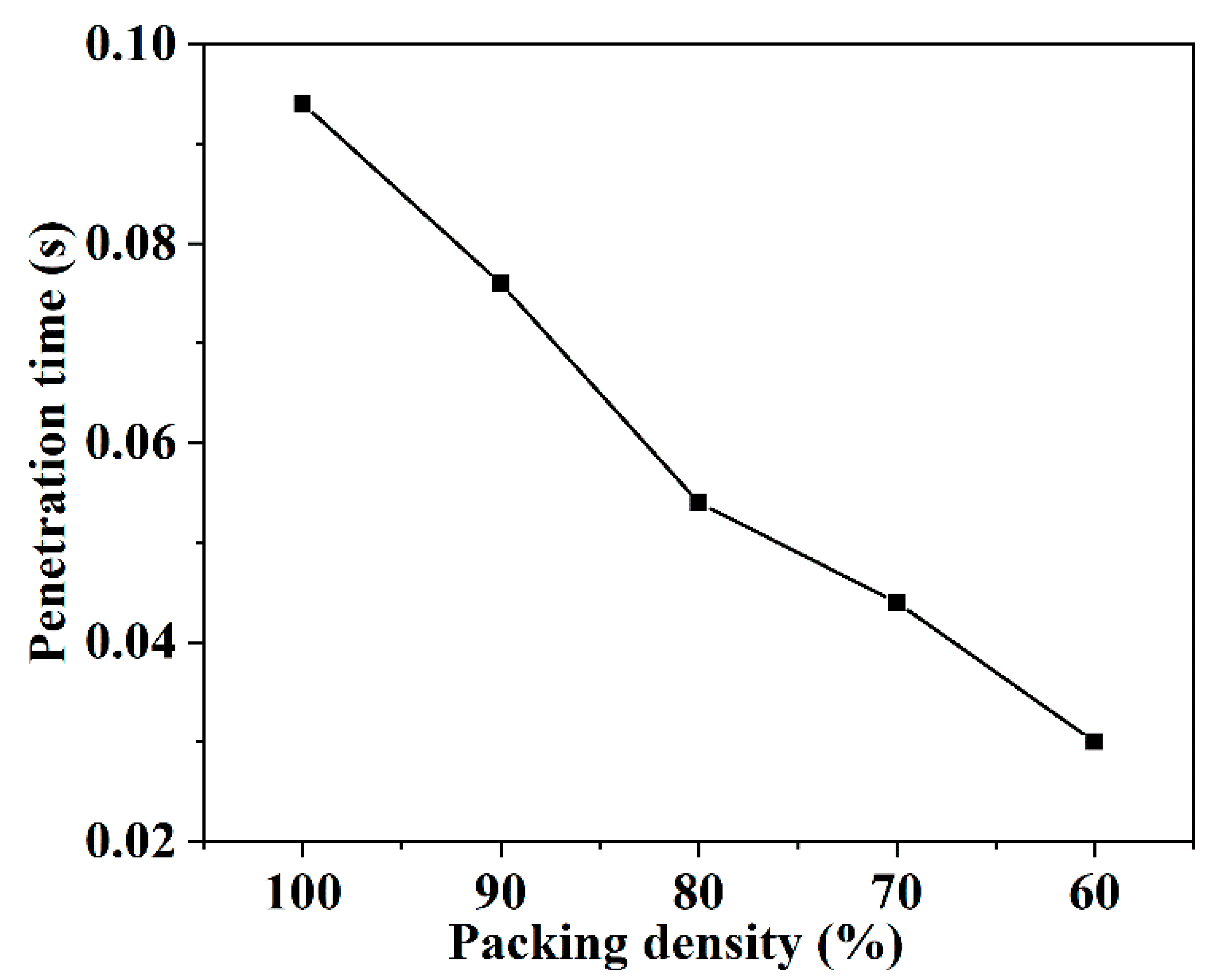

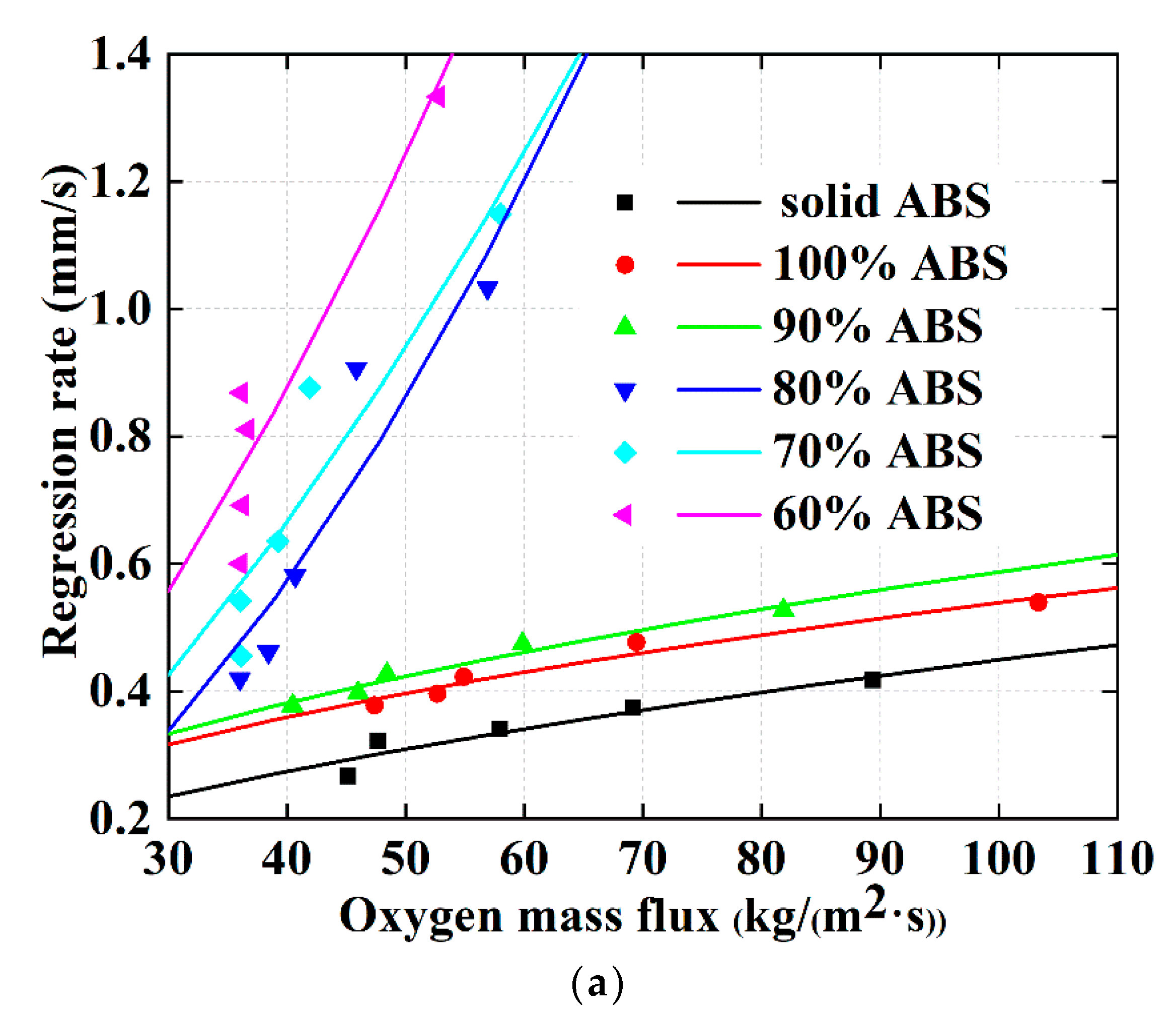
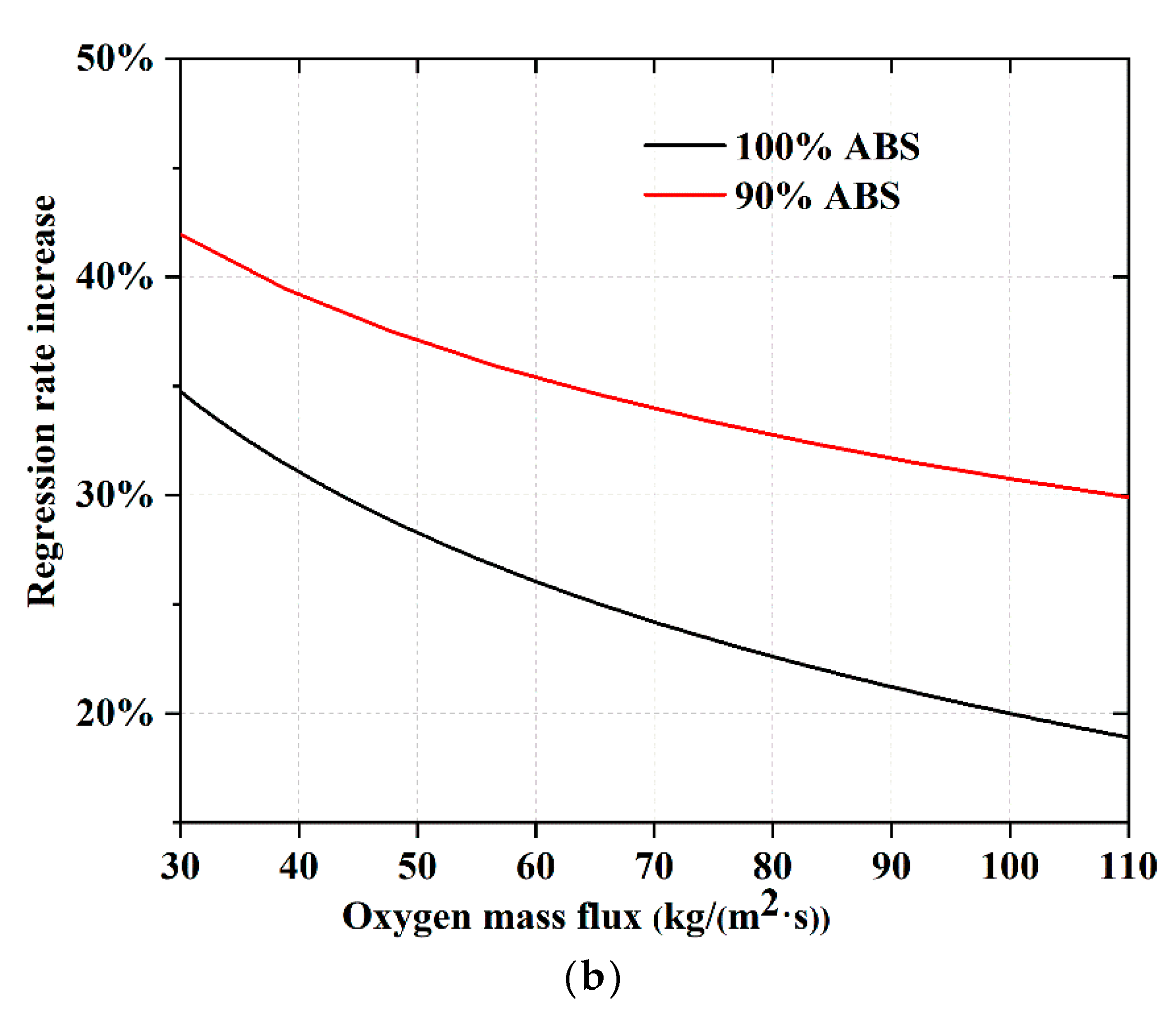
| β (°C/min) | Ti (°C) | Tm (°C) | Tf (°C) | Mi (wt%) | Mm (wt%) | Mf (wt%) |
|---|---|---|---|---|---|---|
| 5 | 332.3 | 408.6 | 481.4 | 99 | 51.20 | 1.46 |
| 10 | 371.8 | 423.3 | 493.8 | 99 | 49.88 | 2.56 |
| 20 | 384.2 | 438.1 | 508.5 | 99 | 46.34 | 2.24 |
| 30 | 396.8 | 460.8 | 526.3 | 99 | 36.83 | 2.11 |
| β (°C/min) | Ti (°C) | Tm (°C) | Tf (°C) | Mi (wt%) | Mm (wt%) | Mf (wt%) |
|---|---|---|---|---|---|---|
| 5 | 307.4 | 388.5 | 546.5 | 99 | 55.69 | 1.25 |
| 10 | 309.7 | 405.9 | 567.5 | 99 | 52.34 | 0.44 |
| 20 | 335.1 | 433.1 | 599.6 | 99 | 46.56 | 0.97 |
| 30 | 350.2 | 439.7 | 609.9 | 99 | 49.37 | 0.69 |
| Sample | |||
|---|---|---|---|
| Solid ABS | 0.038 ± 0.016 | 0.539 ± 0.101 | 0.904 |
| 100% ABS | 0.070 ± 0.015 | 0.442 ± 0.049 | 0.963 |
| 90% ABS | 0.067 ± 0.013 | 0.470 ± 0.047 | 0.970 |
| 80% ABS | 0.0007 ± 0.001 | 1.828 ± 0.419 | 0.865 |
| 70% ABS | 0.002 ± 0.003 | 1.548 ± 0.327 | 0.872 |
| 60% ABS | 0.003 ± 0.003 | 1.567 ± 0.315 | 0.873 |
Publisher’s Note: MDPI stays neutral with regard to jurisdictional claims in published maps and institutional affiliations. |
© 2022 by the authors. Licensee MDPI, Basel, Switzerland. This article is an open access article distributed under the terms and conditions of the Creative Commons Attribution (CC BY) license (https://creativecommons.org/licenses/by/4.0/).
Share and Cite
Yu, X.; Yu, H.; Zhang, W.; DeLuca, L.T.; Shen, R. Effect of Penetrative Combustion on Regression Rate of 3D Printed Hybrid Rocket Fuel. Aerospace 2022, 9, 696. https://doi.org/10.3390/aerospace9110696
Yu X, Yu H, Zhang W, DeLuca LT, Shen R. Effect of Penetrative Combustion on Regression Rate of 3D Printed Hybrid Rocket Fuel. Aerospace. 2022; 9(11):696. https://doi.org/10.3390/aerospace9110696
Chicago/Turabian StyleYu, Xiaodong, Hongsheng Yu, Wei Zhang, Luigi T. DeLuca, and Ruiqi Shen. 2022. "Effect of Penetrative Combustion on Regression Rate of 3D Printed Hybrid Rocket Fuel" Aerospace 9, no. 11: 696. https://doi.org/10.3390/aerospace9110696





